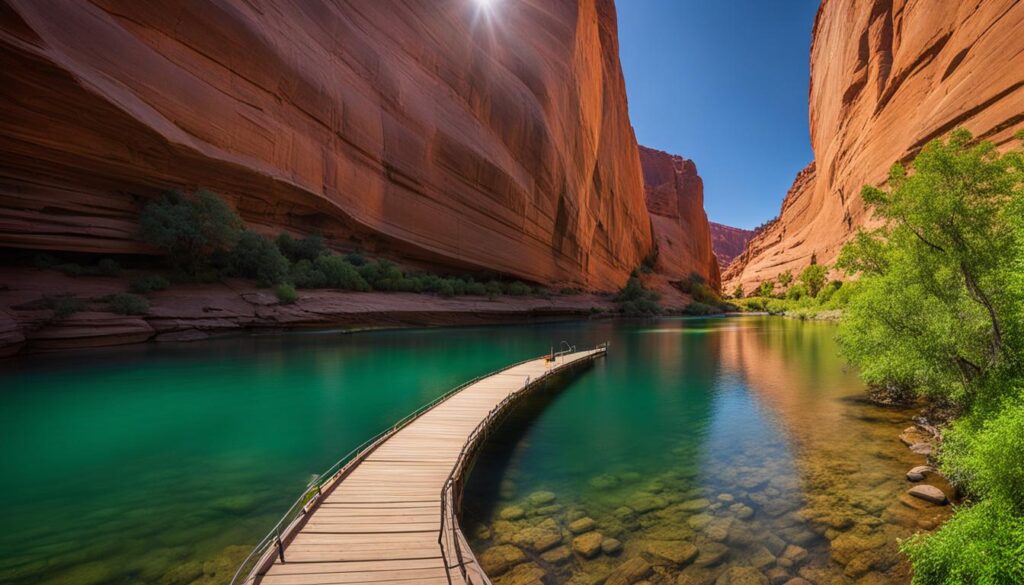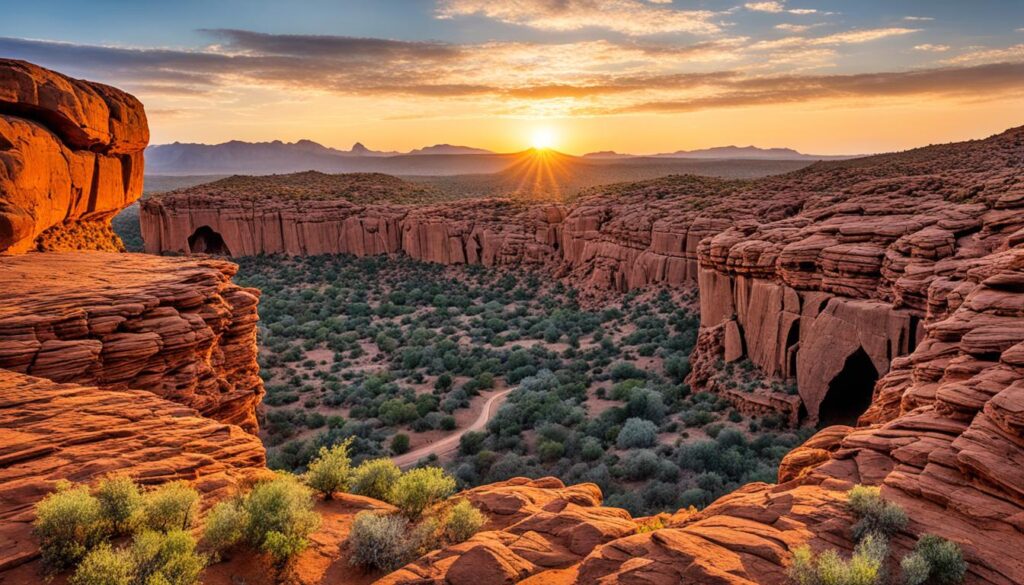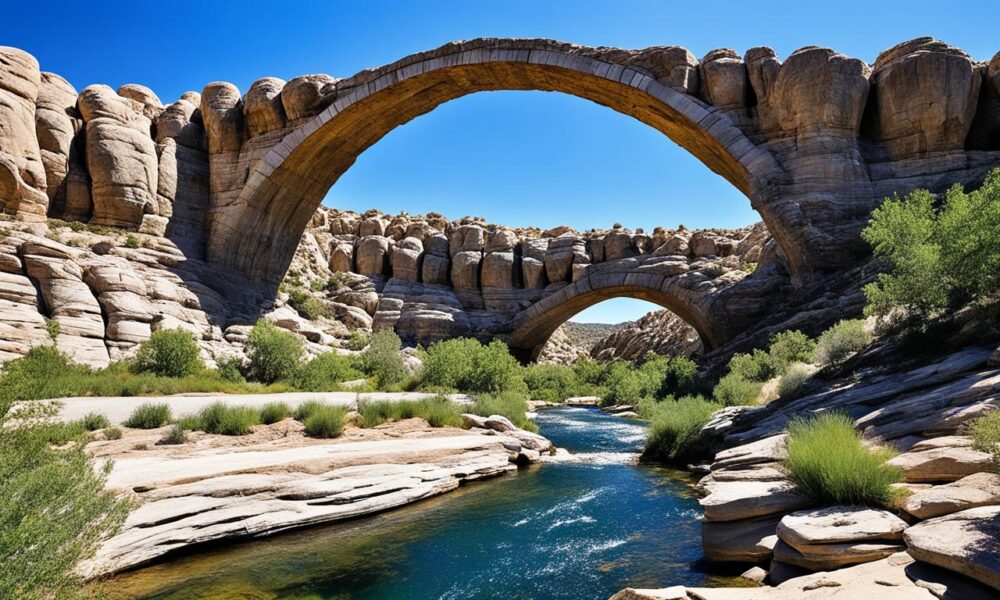World’s Largest Natural Stone Bridge Explored
Rainbow Bridge, the largest natural stone bridge in the world, is an iconic natural landmark and a geological wonder to behold. Located in the Glen Canyon National Recreation Area, it attracts 85,000 visitors annually. Neighboring American Indian tribes consider it sacred, adding to its cultural significance.
Key Takeaways:
- Rainbow Bridge is the largest natural stone bridge in the world.
- It is an iconic natural landmark and a geological wonder.
- Located in the Glen Canyon National Recreation Area.
- It attracts 85,000 visitors annually.
- Considered sacred by neighboring American Indian tribes.
The Distinction between Arches and Bridges
In the world of natural formations, there is a distinct difference between natural arches and natural bridges. The Natural Arch and Bridge Society provides valuable insights into the unique characteristics that set these geological wonders apart.
A natural arch is a remarkable formation formed by rocks with holes created by powerful natural forces. These forces could be the result of erosion, wind, or other geological phenomena. Over time, the forces shape the rock into a stunning arch, creating a visually captivating spectacle.
On the other hand, a natural bridge is a specific type of arch formed primarily by the erosive power of water. Unlike natural arches, natural bridges are intricately connected to the presence of flowing water that has skillfully carved through solid rock, creating a passage that spans across a gap or waterbody.
Both natural arches and natural bridges exhibit the incredible forces of nature and showcase the intricate interplay between geological formations and natural processes. While natural arches showcase the power of wind and erosion, natural bridges exemplify the erosive forces of water over time.
“The distinction between natural arches and bridges lies in the specific geological forces behind their formation. Both are awe-inspiring in their own right, demonstrating the magnificence of nature’s sculpting abilities.” – Natural Arch and Bridge Society
To fully appreciate the distinctiveness of natural arches and natural bridges, it’s important to delve deeper into their formation and the geological forces that shape these mesmerizing creations.
Magnificent Natural Bridges Around the World
When it comes to spectacular natural bridges and geological formations, the world never falls short of breathtaking wonders. From the Green Bridge of Wales to the Ayres Natural Bridge in Wyoming, these natural marvels awe-inspire visitors from all corners of the globe.
One of the most famous sites showcasing these natural wonders is the Natural Bridges National Monument in Utah. Nestled within the rugged landscape, this national park is home to three mighty bridges named Owachomo, Kachina, and Sipapu. These geological formations, with their imposing beauty and intricate rock formations, never fail to leave visitors in awe.
If you’re seeking a unique and mesmerizing experience, France’s Pont d’Arc is a natural arch that shouldn’t be missed. Located in the Chauvet cave paintings UNESCO site, this stunning natural bridge offers a captivating glimpse into ancient history and the mesmerizing power of geological forces.
Magnificent Natural Bridges Around the World
| Location | Natural Bridge | Notes |
|---|---|---|
| Wales, United Kingdom | Green Bridge | A natural limestone arch on the Welsh coastline. |
| Wyoming, United States | Ayres Natural Bridge | A stunning sandstone bridge in a picturesque natural setting. |
| Utah, United States | Owachomo, Kachina, and Sipapu Bridges | Majestic natural bridges within Natural Bridges National Monument. |
| France | Pont d’Arc | A famous natural arch showcasing ancient cave paintings. |
These natural bridges not only offer a glimpse into the remarkable power of geological forces but also provide opportunities for exploration and appreciation of the natural world. Whether you’re a nature enthusiast or simply seeking awe-inspiring beauty, these magnificent formations in national parks and protected areas are sure to leave a lasting impression.
Natural Bridges and Roadside Attractions in Arizona
Arizona is a treasure trove of natural wonders, offering breathtaking landscapes and unique experiences for adventurous travelers. From unusual rock formations to ghost towns and historical locations, the state is renowned for its diverse array of attractions. Whether you’re planning a road trip or seeking roadside wonders, Arizona has something for everyone.
One of the must-visit destinations in Arizona is Jerome, a charming hillside town rich in history and culture. Explore its historic buildings, art galleries, and enjoy panoramic views of the surrounding landscape. The town’s unique character and artistic vibe make it a perfect stop for art enthusiasts and history buffs alike.
Another fascinating location is Sedona, known for its stunning red rock formations and spiritual energy. Take a hike in the scenic red rock canyons, explore vortex sites, or indulge in wellness retreats. Sedona is a paradise for nature lovers and those seeking relaxation and rejuvenation.
For lovers of architectural marvels, Casa Grande Domes in Casa Grande is a must-see. These futuristic domes were originally built as a resort and offer a peek into the past. While the resort project didn’t reach its full potential, the domes remain a captivating sight for visitors interested in unique architecture.
If you’re up for a classic American road trip experience, Historic Route 66 in Arizona is the perfect choice. As you drive along this iconic highway, you’ll encounter a myriad of roadside attractions that showcase the quirky side of Arizona. These attractions range from kitschy motels and vintage diners to funky art installations and nostalgic landmarks.
Experience the charm of Arizona’s natural wonders and indulge in the excitement of exploring roadside attractions on an unforgettable journey through the state.
| Destination | Description |
|---|---|
| Jerome | A historic hillside town with rich history and artistic vibe. |
| Sedona | A mesmerizing destination with stunning red rock formations and spiritual energy. |
| Casa Grande Domes | Futuristic domes that offer a glimpse into unique architecture. |
| Historic Route 66 | An iconic highway filled with quirky roadside attractions and nostalgia. |
Explore the natural wonders, embrace the road trip spirit, and discover the hidden gems of Arizona.
Rainbow Bridge National Monument
Rainbow Bridge, located in Glen Canyon National Recreation Area, is one of the largest natural bridges in the world. This magnificent geological marvel spans 275 feet and attracts thousands of visitors each year. Its grandeur and cultural significance make it a must-visit destination for nature enthusiasts and history lovers alike.
The Rainbow Bridge holds immense cultural significance for the American Indian tribes in the region. According to their beliefs, the bridge is a sacred symbol of their connection to their ancestors and the spiritual world. It is a place of reverence and pilgrimage, where prayers are offered and traditions are honored.
Visitors to the Rainbow Bridge National Monument can witness the awe-inspiring beauty of this natural wonder up close. The bridge’s unique arch shape and the surrounding breathtaking canyon views create an unforgettable experience. Whether you choose to approach the Rainbow Bridge by boat or hike along the winding trails, the journey is filled with natural wonders and stunning vistas.
“Rainbow Bridge is not only a geological wonder but also a testament to the rich cultural heritage of the American Indian tribes. Its towering presence and majestic beauty leave visitors in awe, reminding us of the power and beauty of nature.” – National Park Service
To truly appreciate the significance and beauty of Rainbow Bridge, it’s essential to acknowledge the preservation efforts put forth by the National Park Service. They work tirelessly to protect and maintain this natural treasure, ensuring that future generations can witness its magnificence and learn about its cultural importance.
Notable Features of Rainbow Bridge National Monument
The Rainbow Bridge National Monument offers several notable features and attractions for visitors to explore. Here are a few highlights:
- The bridge’s massive span, measuring 275 feet, is a testament to the incredible forces of nature.
- The surrounding Glen Canyon offers stunning views and diverse flora and fauna.
- Boat tours and hiking trails provide different perspectives and opportunities for adventure.
- Educational programs and ranger-led activities offer insight into the bridge’s formation and cultural significance.
| Location | Size | Cultural Significance |
|---|---|---|
| Glen Canyon National Recreation Area, Utah | Span of 275 feet | Sacred symbol for American Indian tribes |
Plan your visit to Rainbow Bridge National Monument and witness the majesty of this natural wonder firsthand. Whether you embark on a guided tour or explore the trails independently, this experience is sure to leave a lasting impression and deepen your appreciation for the beauty and cultural significance of Rainbow Bridge.
Geology of Rainbow Bridge
Rainbow Bridge’s formation is a result of millions of years of natural geological processes. Situated in the stunning Glen Canyon, this majestic natural wonder showcases the intricate power of nature and offers a glimpse into the Earth’s fascinating history.
The formation of Rainbow Bridge began with various geological forces at play. Over time, water erosion carved out a deep, narrow canyon, creating the conditions for the bridge to form. The bridge’s unique arch shape, spanning 275 feet and standing at a breathtaking height of 290 feet, is a testament to the sheer force of water over the ages.
The geological processes that shaped Rainbow Bridge are a testament to the incredible forces at work in our planet. Witnessing the raw power of nature in the formation of this iconic bridge is truly awe-inspiring.
As water continuously flowed through the canyon, it gradually eroded the sandstone walls, sculpting the natural arch that we see today. Layers of sediment deposited over millions of years formed the distinct striations and coloration visible on the surface of Rainbow Bridge, adding to its allure.
The Glen Canyon region, where Rainbow Bridge is located, is known for its unique geology. The area is characterized by layered sandstone formations, carved out by the relentless forces of wind and water. These geological features make the region a haven for geologists and nature enthusiasts alike.
To truly appreciate the geological significance of Rainbow Bridge, visitors can embark on a guided tour that delves deeper into the formation processes and the geological history of the area. This provides a comprehensive understanding of the natural forces that have shaped this extraordinary landmark.
Fascinating Geological Features at Rainbow Bridge
While Rainbow Bridge itself is undeniably the main attraction, the surrounding area is also rich in various geological wonders. Visitors can explore the intricate rock formations, intricate patterns, and vibrant colors that adorn the canyon walls. From exposed layers of ancient rock to fossilized marine life, the geology of Glen Canyon offers a glimpse into the geological history of the region.
The geological formations surrounding Rainbow Bridge are a testament to the ever-changing landscape and the forces that continue to shape our planet. It is a remarkable sight that leaves visitors in awe of the grandeur and beauty of nature.
How to Visit Rainbow Bridge
Visitors to Rainbow Bridge have two options for accessing this natural wonder: hiking trails or dock access. Both options provide unique perspectives and opportunities to experience the beauty of Glen Canyon.
Hiking Trails
For those who enjoy outdoor adventures, hiking trails offer an immersive experience amidst the stunning landscape. The well-maintained trails in Glen Canyon National Recreation Area provide an opportunity to explore the area’s natural beauty while making your way to Rainbow Bridge. The trails are marked and suitable for a range of hiking abilities, from beginners to experienced hikers.
To access the hiking trails, park your vehicle at the designated parking area and follow the clearly marked trailhead. As you hike, you’ll have the chance to witness the breathtaking scenery and discover the unique flora and fauna that call Glen Canyon home. Remember to bring water, snacks, and suitable hiking gear to ensure a comfortable trek.
Note: It is essential to follow the park’s rules and regulations while hiking to preserve the delicate ecosystem and ensure the safety and enjoyment of all visitors.
Dock Access
If you prefer a more leisurely approach, dock access provides a convenient way to visit Rainbow Bridge. The Glen Canyon National Recreation Area offers boating opportunities on Lake Powell, allowing visitors to reach the bridge by water. Powerboats, kayaks, and tour boats are available for rent, making it easy to navigate the lake’s vast expanse.
Once you arrive at Rainbow Bridge, you can dock your boat and take a short walk to the bridge for an up-close view of this magnificent natural formation. The dock area is well-maintained, and park staff are available to provide assistance and answer any questions you may have.
Note: It is important to respect the park’s rules and regulations regarding watercraft and safety guidelines while enjoying your visit.
Before planning your visit, it is recommended to check the official Glen Canyon National Recreation Area website for up-to-date information, including trail conditions, boating regulations, and any temporary closures or restrictions that may be in place. Guided tours and ranger-led programs are also available for those seeking a more in-depth exploration of Rainbow Bridge and its surrounding area.

Other Natural Bridges Around the World
When it comes to natural wonders, the world is full of breathtaking and awe-inspiring sights. Natural bridges, with their unique formations and majestic spans, are among these remarkable geological marvels. Let’s explore some famous examples of natural bridges found in various countries across the globe.
China:
China boasts several natural bridges that showcase the country’s diverse landscape. One notable example is the Xanadu Bridge, located in Guangxi province. With a span of over 100 meters, this bridge captivates visitors with its intricate rock formations and lush surroundings.
The Czech Republic:
In the heart of Europe, the Czech Republic is home to the enchanting Pravčická brána. This iconic sandstone arch, situated in Bohemian Switzerland National Park, is the largest natural bridge in Europe. Its picturesque setting attracts hikers and nature enthusiasts from around the world.
Jordan:
In the captivating desert landscapes of Jordan, the Um Qais Natural Bridge stands as a testament to the power of erosion. Formed over centuries, this bridge showcases the stunning geological formations that characterize the region.
Afghanistan:
The natural beauty of Afghanistan is further enhanced by stunning natural bridges like the Darband Natural Bridge. Located in Bamyan province, this colossal arch stretches across a deep gorge, leaving visitors in awe of its grandeur.
These natural bridges are just a small glimpse into the diverse array of geological formations found across the globe. Each bridge tells a unique story of natural forces at work, shaping the world we inhabit. Witnessing the beauty of these bridges firsthand is an unforgettable experience that highlights the remarkable wonders of our planet.
| Country | Natural Bridge | Span (meters) |
|---|---|---|
| China | Xanadu Bridge | 100+ |
| The Czech Republic | Pravčická brána | Unknown |
| Jordan | Um Qais Natural Bridge | Unknown |
| Afghanistan | Darband Natural Bridge | Unknown |
These remarkable natural bridges around the world are a testament to the power of nature and the beauty it creates. Exploring these geological wonders offers a glimpse into the awe-inspiring diversity of our planet’s landscapes.
The Historical Significance of Natural Bridges
Virginia’s Natural Bridge holds historical significance as one of the earliest recognized natural wonders in the English colonies. Owned by none other than Thomas Jefferson himself, this remarkable geological formation has witnessed centuries of human history and admiration.
The beauty and grandeur of the Natural Bridge in Virginia have captivated visitors for generations. This magnificent natural landmark has been the subject of awe and inspiration, attracting notable historical figures such as George Washington and Thomas Jefferson.
Thomas Jefferson, the third President of the United States and a renowned statesman, considered the Natural Bridge a national treasure. He purchased the land surrounding the bridge and even built a small cabin nearby, appreciating its natural splendor and geological significance.
Jefferson’s connection to the Natural Bridge extends beyond personal admiration. He recognized its value as a historical landmark and symbol of the nation’s natural heritage. In fact, he included an engraving of the Natural Bridge in his influential book, “Notes on the State of Virginia,” further highlighting its significance.
“It is impossible for the emotions arising from the sublime to be felt beyond what they are here: so beautiful an arch, so elevated, so light, and springing as it were up to heaven, the rapture of the spectator is really indescribable!”
The Natural Bridge in Virginia remains an enduring testament to the geological wonders of the world and the cultural significance it holds in American history. Today, it is preserved as a state park, attracting visitors from around the globe who come to marvel at this natural masterpiece.
Notable Historical Landmarks in Virginia
| Landmark | Location | Significance |
|---|---|---|
| Jamestown | James City County | The first permanent English settlement in North America |
| Monticello | Charlottesville | Thomas Jefferson’s primary residence and architectural masterpiece |
| Mount Vernon | Mount Vernon | George Washington’s plantation and final resting place |
| The Carter’s Grove Plantation | Williamsburg | A well-preserved example of colonial Virginia architecture |
Virginia’s natural and historical landmarks, including the Natural Bridge, serve as a testament to the rich heritage and extraordinary beauty of this remarkable state. Filled with awe-inspiring landscapes and enduring historical significance, Virginia is a destination that offers both natural wonders and a glimpse into the nation’s past.
Natural Bridges and Rock Formations in Algeria
Algeria’s Tassili n’Ajjer, a UNESCO World Heritage site in the southeastern region of the country, is renowned not only for its ancient cave drawings but also for its impressive collection of natural bridges and rock formations. These natural wonders provide a fascinating glimpse into the geological history of the area, showcasing the enduring power of natural forces and the impact of environmental changes over time.

Rock Forests and Majestic Bridges
Within the vast expanse of Tassili n’Ajjer, visitors can explore the intriguing landscape of rock forests, where towering formations create a surreal and otherworldly atmosphere. These unique rock formations, shaped by the erosion of wind and water over millions of years, stand as testaments to the ever-evolving natural forces that have shaped the Earth.
Amidst this rocky wonderland, natural bridges gracefully span across canyons and valleys, defying gravity and captivating the imagination. These bridges, formed through the same geological processes that shaped the surrounding landscape, serve as resilient reminders of the intricate dance between nature’s timeless forces.
Preserving a National Treasure
The awe-inspiring natural bridges and rock formations of Tassili n’Ajjer are not just remarkable visual spectacles but also hold immense cultural and historical significance. They have long been revered by the indigenous peoples of the region, serving as gathering places and sacred sites. The preservation of this extraordinary natural heritage as a UNESCO World Heritage site ensures that future generations can continue to marvel at its beauty and appreciate its intrinsic value.
Exploring Tassili n’Ajjer
For those fortunate enough to visit Tassili n’Ajjer, there are various hiking trails and guided tours available to explore the natural wonders of the area. These expeditions offer a chance to witness the incredible rock formations up close, walk amidst the majestic natural bridges, and immerse oneself in the sheer grandeur of this UNESCO World Heritage site.
| Natural Bridges and Rock Formations in Tassili n’Ajjer | Description |
|---|---|
| Towering Rock Forests | Experience the mesmerizing sight of expansive rock forests, where towering formations dominate the landscape. |
| Graceful Natural Bridges | Marvel at the breathtaking natural bridges that elegantly span across canyons and valleys. |
| Cultural Significance | Discover the rich cultural and historical importance of these natural wonders to the local indigenous communities. |
| Guided Tours and Hiking Trails | Embark on unforgettable expeditions, guided by knowledgeable experts, and explore the wonders of Tassili n’Ajjer. |
Natural Bridges and Roadside Attractions in Canada
Canada is home to some of the most spectacular natural landscapes in the world. While Banff National Park is renowned for its breathtaking beauty, Yoho National Park is equally impressive with its towering peaks and stunning natural formations. One such natural wonder in Yoho National Park is the natural bridge carved by the Kicking Horse River. This magnificent bridge, formed over thousands of years of erosion, is a testament to the raw power of nature.
But Canada’s attractions don’t stop at its national parks. Along Historic Route 66 in Canada, you’ll find a treasure trove of roadside attractions that are sure to captivate travelers. From quirky museums to charming diners, these stops offer a glimpse into the rich cultural heritage of the region. And if you’re looking for a cozy place to rest during your road trip, the roadside motels in Canada provide comfort and convenience that make your journey even more enjoyable.
Explore Banff National Park and Yoho National Park
Both Banff National Park and Yoho National Park offer unparalleled opportunities for outdoor adventure and exploration. From hiking through lush forests to witnessing the majesty of glacier-fed lakes, these parks are a nature lover’s paradise. Banff National Park is particularly famous for its stunning turquoise-colored lakes like Lake Louise and Moraine Lake, while Yoho National Park boasts picturesque waterfalls such as Takakkaw Falls.
“The natural beauty of Banff and Yoho parks is truly awe-inspiring. I felt a profound sense of peace and tranquility as I stood in the presence of these majestic landscapes.”
Whether you’re an avid hiker, wildlife enthusiast, or simply in search of breathtaking views, a visit to Banff National Park and Yoho National Park should be on your bucket list.
Adventures Along Historic Route 66
Traveling along Historic Route 66 in Canada is like taking a journey back in time. This iconic highway offers a glimpse into the rich history and culture of the country. As you drive through charming small towns and scenic landscapes, you’ll come across a myriad of quirky roadside attractions that will pique your curiosity and make for memorable photo opportunities.
- Discover the vintage charm of roadside diners, where you can savor delicious comfort food and experience a slice of authentic Canadian culture.
- Explore unique museums showcasing everything from classic cars to folk art, providing insight into the local heritage.
- Uncover hidden gems like unusual art installations and whimsical statues that add a touch of whimsy to your road trip.
Each stop along Historic Route 66 in Canada holds its own unique charm and tells a story that adds to the rich tapestry of the country’s history.
So, whether you’re exploring the natural wonders of Banff National Park and Yoho National Park or embarking on an adventure along Historic Route 66, Canada offers a plethora of attractions that are sure to leave you in awe. Immerse yourself in the beauty of nature, embrace the warmth of Canadian hospitality, and create memories that will last a lifetime.
Conclusion
Rainbow Bridge, known as the largest natural stone bridge in the world, is an awe-inspiring geological wonder that should not be missed. Its immense size and breathtaking beauty make it a top natural wonder globally.
With its cultural significance to neighboring American Indian tribes and its iconic status as a natural landmark, Rainbow Bridge attracts visitors from around the world. Standing in the presence of this magnificent natural formation leaves visitors in awe of the immense power of geological forces that shaped it over millions of years.
Whether you are a nature enthusiast, a history buff, or simply someone seeking to be captivated by the wonders of the natural world, Rainbow Bridge offers an unforgettable experience. Plan your visit to this extraordinary natural bridge and marvel at the grandeur of one of Earth’s most remarkable geological formations.



